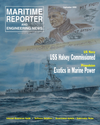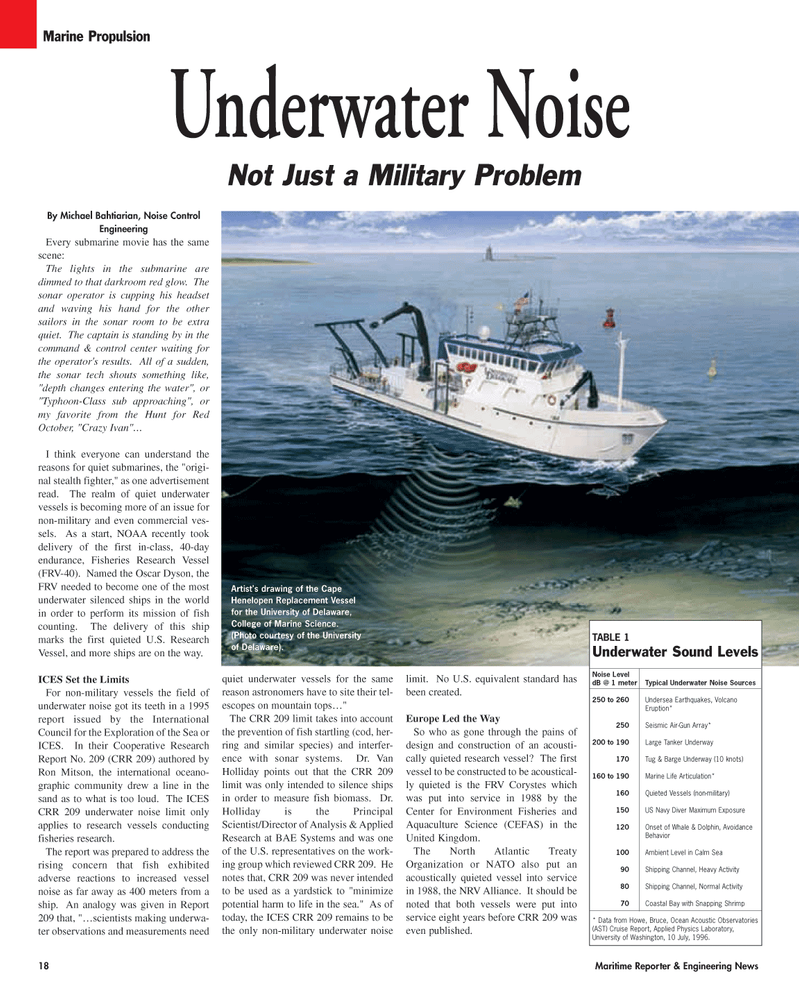
Page 18: of Maritime Reporter Magazine (September 2005)
Marine Propulsion Annual
Read this page in Pdf, Flash or Html5 edition of September 2005 Maritime Reporter Magazine
By Michael Bahtiarian, Noise Control
Engineering
Every submarine movie has the same scene:
The lights in the submarine are dimmed to that darkroom red glow. The sonar operator is cupping his headset and waving his hand for the other sailors in the sonar room to be extra quiet. The captain is standing by in the command & control center waiting for the operator's results. All of a sudden, the sonar tech shouts something like, "depth changes entering the water", or "Typhoon-Class sub approaching", or my favorite from the Hunt for Red
October, "Crazy Ivan"…
I think everyone can understand the reasons for quiet submarines, the "origi- nal stealth fighter," as one advertisement read. The realm of quiet underwater vessels is becoming more of an issue for non-military and even commercial ves- sels. As a start, NOAA recently took delivery of the first in-class, 40-day endurance, Fisheries Research Vessel (FRV-40). Named the Oscar Dyson, the
FRV needed to become one of the most underwater silenced ships in the world in order to perform its mission of fish counting. The delivery of this ship marks the first quieted U.S. Research
Vessel, and more ships are on the way.
ICES Set the Limits
For non-military vessels the field of underwater noise got its teeth in a 1995 report issued by the International
Council for the Exploration of the Sea or
ICES. In their Cooperative Research
Report No. 209 (CRR 209) authored by
Ron Mitson, the international oceano- graphic community drew a line in the sand as to what is too loud. The ICES
CRR 209 underwater noise limit only applies to research vessels conducting fisheries research.
The report was prepared to address the rising concern that fish exhibited adverse reactions to increased vessel noise as far away as 400 meters from a ship. An analogy was given in Report 209 that, "…scientists making underwa- ter observations and measurements need quiet underwater vessels for the same reason astronomers have to site their tel- escopes on mountain tops…"
The CRR 209 limit takes into account the prevention of fish startling (cod, her- ring and similar species) and interfer- ence with sonar systems. Dr. Van
Holliday points out that the CRR 209 limit was only intended to silence ships in order to measure fish biomass. Dr.
Holliday is the Principal
Scientist/Director of Analysis & Applied
Research at BAE Systems and was one of the U.S. representatives on the work- ing group which reviewed CRR 209. He notes that, CRR 209 was never intended to be used as a yardstick to "minimize potential harm to life in the sea." As of today, the ICES CRR 209 remains to be the only non-military underwater noise limit. No U.S. equivalent standard has been created.
Europe Led the Way
So who as gone through the pains of design and construction of an acousti- cally quieted research vessel? The first vessel to be constructed to be acoustical- ly quieted is the FRV Corystes which was put into service in 1988 by the
Center for Environment Fisheries and
Aquaculture Science (CEFAS) in the
United Kingdom.
The North Atlantic Treaty
Organization or NATO also put an acoustically quieted vessel into service in 1988, the NRV Alliance. It should be noted that both vessels were put into service eight years before CRR 209 was even published.
Marine Propulsion 18 Maritime Reporter & Engineering News
Underwater Noise
Not Just a Military Problem
Artist's drawing of the Cape
Henelopen Replacement Vessel for the University of Delaware,
College of Marine Science. (Photo courtesy of the University of Delaware).
TABLE 1
Underwater Sound Levels
Noise Level dB @ 1 meter Typical Underwater Noise Sources 250 to 260 Undersea Earthquakes, Volcano
Eruption* 250 Seismic Air-Gun Array* 200 to 190 Large Tanker Underway 170 Tug & Barge Underway (10 knots) 160 to 190 Marine Life Articulation* 160 Quieted Vessels (non-military) 150 US Navy Diver Maximum Exposure 120 Onset of Whale & Dolphin, Avoidance
Behavior 100 Ambient Level in Calm Sea 90 Shipping Channel, Heavy Activity 80 Shipping Channel, Normal Activity 70 Coastal Bay with Snapping Shrimp * Data from Howe, Bruce, Ocean Acoustic Observatories (AST) Cruise Report, Applied Physics Laboratory,
University of Washington, 10 July, 1996.
MR SEPTEMBER 2005 #3 (17-24).qxd 9/1/2005 11:24 AM Page 18

 17
17

 19
19
